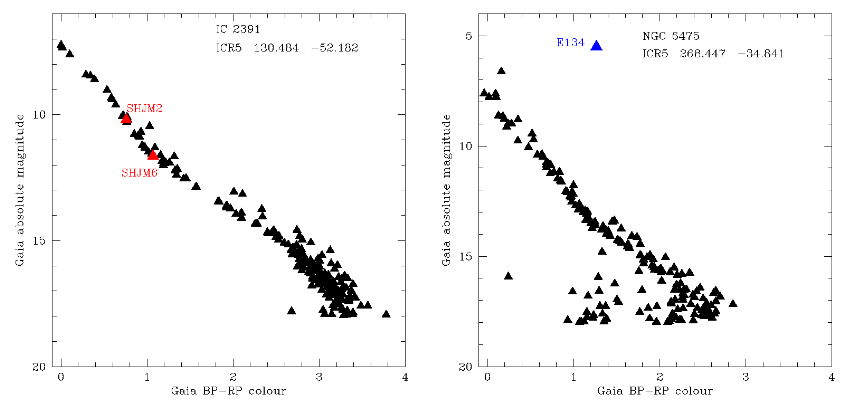Resumen
Los cúmulos abiertos son objetos muy útiles en astrofísica; se han utilizado para estudiar la teoría de la formación y la evolución estelar, así como la estructura de la vía láctea. En ese contexto, se analizaron estrellas enanas y gigantes pertenecientes a los cúmulos abiertos IC 2391 y NGC 6475. Los espectros de alta resolución se obtuvieron de la base de datos ESO/Archive. Para obtener los parámetros atmosféricos (Teff, log g, ε, [Fe/H]) y las abundancias químicas, se aplicó la hipótesis del equilibrio termodinámico local (local thermodynamic equilibrium, LTE). Nuestros resultados corroboraron el comportamiento de las abundancias químicas en el disco galáctico.
Referencias
Beers, T.C., Carollo, D. (2009). Galactic archaeology: Overcoming great barriers. Nature Physics, 5(7), 463-464.
Cantat-Gaudin, T., Anders, F., Castro-Ginard, A., Jordi, C., Romero-Go´mez, M., Soubi- ran, C., Casamiquela, L., Tarricq, Y., Moitinho, A., Vallenari, A., Bragaglia, A., Krone-Martins, A., Kounkel, M. (2020). Painting a portrait of the Galactic disc with its stellar clusters. Astronomy and Astrophysics, 640, Article A1, A1. https://doi.org/10.1051/0004-6361/202038192
De Silva, G. M., D’Orazi, V., Melo, C., Torres, C. A. O., Gieles, M., Quast, G. R., Sterzik, M. (2013). Search for associations containing young stars: chemical tagging IC 2391 and the Argus association. Monthly Notices of the Royal Astronomical Society, 431(2), 1005-1018. https://doi.org/10.1093/mnras/stt153
Delgado-Mena, E., Moya, A., Adibekyan, V., Tsantaki, M., González-Hernández, J. I., Israelian, G., Davies, G. R., Chaplin, W. J., Sousa, S. G., Ferreira, A. C. S., Santos, N. C. (2019). Abundance to age ratios in the HARPS-GTO sample with Gaia DR2. Chemical clocks for a range of [Fe/H]. Astronomy and Astrophysics, 624, A78. https://doi.org/10.1051/0004-6361/201834783
Feinstein, A. (1961). Spectroscopic Observations of M 7. Publications of the Astronomical Society of the Pacific, 73(435), 452. https://doi.org/10.1086/127728
Gaia Collaboration. (2018). VizieR Online Data Catalog: Gaia DR2 (Gaia Collaboration, 2018). VizieR Online Data Catalog, Article I/345.
Gaia Collaboration. (2022). VizieR Online Data Catalog: Gaia DR3 Part 1. Main source (Gaia Collaboration, 2022). VizieR Online Data Catalog, Article I/355.
Jacobson, H. R., Friel, E. D., Jılková, L., Magrini, L., Bragaglia, A., Vallenari, A., Tosi, M., Randich, S., Donati, P., Cantat-Gaudin, T., Sordo, R., Smiljanic, R., Overbeek, J. C., Carraro, G., Tautvaišienė, G., San Roman, I., Villanova, S., Geisler, D., Muñoz, C., . . Zaggia, S. (2016). The Gaia-ESO Survey: Probes of the inner disk abundance gradient. Astronomy and Astrophysics, 591, Article A37. https://doi.org/10.1051/0004-6361/201527654
Katime-Santrich, O. J., Kerber, L., Abuchaim, Y., Gonçalves, G. (2022). On the validity of the spectroscopic age indicators [Y/Mg], [Y/Al], [Y/Si], [Y/Ca], and [Y/Ti] for giant stars. Monthly Notices of the Royal Astronomical Society, 514(4), 4816-4827. https://doi.org/10.1093/mnras/stac1183
Katime-Santrich, O.J.K., Pereira, C.B., Drake, N.A. (2013). Chemical analysis of giant stars in the young open cluster NGC 3114. Astronomy and Astrophysics, 554, Article A2, https://doi.org/10.1051/0004-6361/201220252
Kurucz, R. L. (1981). A table of semiempirical gf values. Pt 1: Wavelengths: 5.2682 NM to 272.3380 nm; Pt 2: Wavelengths: 272.3395 NM to 599.3892 nm; Pt 3: Wave-lengths: 599.4004 NM to 9997.2746 NM Pt 4: FeII.
Kurucz, R. L., Peytremann, E. (1975). A table of semiempirical gf values. Pt 1: Wave- lengths: 5.2682 NM to 272.3380 nm; Pt 2: Wavelengths: 272.3395 NM to 599.3892 nm; Pt 3: Wavelengths: 599.4004 NM to 9997.2746 NM. SAO Special Report.
Luck, R. E. (2015). Abundances in the Local Region. I. G and K Giants. The Astrophysical Journal, 150(3), Article 88. https://doi.org/10.1088/0004-6256/150/3/88
Magrini, L., Randich, S., Kordopatis, G., Prantzos, N., Romano, D., Chieffi, A., Limongi, M., François, P., Pancino, E., Friel, E., Bragaglia, A., Tautvaišienė, G., Spina, L., Overbeek, J., Cantat-Gaudin, T., Donati, P., Vallenari, A., Sordo, R., Jiménez- Esteban, F. M., . . . Zaggia, S. (2017). The Gaia-ESO Survey: radial distribution of abundances in the Galactic disc from open clusters and young-field stars. Astronomy and Astrophysics, 603, Article A2. https://doi.org/10.1051/0004-6361/201630294
Magrini, L., Viscasillas-Vázquez, C., Spina, L., Randich, S., Romano, D., Franciosini, E., Recio-Blanco, A., Nordlander, T., D’Orazi, V., Baratella, M., Smiljanic, R., Dantas, M. L.L., Pasquini, L., Spitoni, E., Casali, G., Van der Swaelmen, M., Bensby, T., Stonkute, E., Sacco, S.F.G.G., . . . Morbidelli, L. (2022). The Gaia-ESO survey: mapping the shape and evolution of the radial abundance gradients with open clusters. arXiv e-prints, Article arXiv:2210.15525.
Mermilliod, J. C., Mayor, M., Udry, S. (2008). Red giants in open clusters. XIV. Mean radial velocities for 1309 stars and 166 open clusters. Astronomy and Astrophysics, 485(1), 303-314. https://doi.org/10.1051/0004-6361:200809664
Mermilliod, J., Mayor, M., Udry, S. (2009). Catalogues of radial and rotational velocities of 1253 F-K dwarfs in 13 nearby open clusters. Astronomy and Astrophysics, 498(3), 949-960. https://doi.org/10.1051/0004-6361/200810244
Sales-Silva, J.V., Peña-Suárez, V.J., Katime-Santrich, O.J., Pereira, C.B., Drake, N.A., Roig, F. (2014). High-resolution Spectroscopic Observations of Binary Stars and Yellow Stragglers in Three Open Clusters: NGC 2360, NGC 3680, and NGC 5822. The Astrophysical Journal, 148(5), Article 83. https://doi.org/10.1088/0004-6256/148/5/83

Esta obra está bajo una licencia internacional Creative Commons Atribución-NoComercial-SinDerivadas 4.0.
Derechos de autor 2023 Revista de la Academia Colombiana de Ciencias Exactas, Físicas y Naturales

